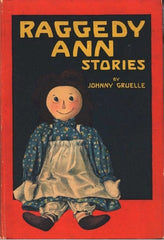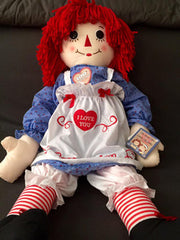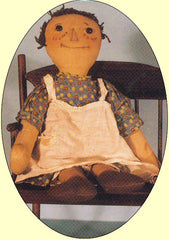On September 7, 1915, US Patent D47789 was issued to Johnny Gruenell for Raggedy Ann.

Johnny Barton Gruenell

Johnny Barton Gruenell
(1880 - 1938)
Mr Gruenell was born in Areola, Illinois, and was an accomplished illustrator working for The New York Herald Newspaper. Until his death in 1938, Mr Gruenell wrote and illustrated over 40 Raggedy Ann books.
Johnny Gruenell's daughter Marcella looking around in the attic found an old cloth rag doll in a barrell that had been made by Mr Gruenell's mother for his sister. Marcella brought the doll to her father and he drew a whimsical face on it. From his bookshelf he pulled a book of poems by James Whitcomb Riley and combined the names of two of the poems, ''The Raggdy Man'', and ''Little Orphaned Annie''. He suggested to Marcella to name the doll Raggedy Ann. The doll had shoe button eyes (buttons were used instead of shoelaces) and a sad smile. "Raggedy Ann" became Marcella's favorite playmate. .

When Marcella was 13 years old, she was vaccinated at school for smallpox. She fell ill and died. Her father was devastated. He blamed the vaccine for her death. Raggedy Ann became the symbol of the anti vaccine cause. Knowing how much Marcella loved Raggedy Ann, he began writing stories about the doll. He applied for a patent on May 28, 1915, and received US patent D47789 for the Raggedy Ann doll on September 7, 1915.

Knowing how much Marcella loved Raggedy Ann, Mr Gruenell introduced the doll to the public in the 1918 book, " The Raggedy Ann Stories". The book was a great success.

A second book was published in 1920 and introduced Raggedy Andy, dressed in a sailor suite and cap.

Many people are surprised to learn the original Raggedy Ann had brown hair and Tin or wooden eyes. The dolls are made completely of cloth and the nose is quite thin. The eyelashes are painted far below the eyes. Some of the earliest and most prized dolls had sewn knee and elbow joints. These rare dolls are highly sought dolls and can command thousands of dollars at auction.
Raggedy Ann and Andy were all originally hand made. But in time they were manufactured.
Mr Gruenell was born in Areola, Illinois, and was an accomplished illustrator working for The New York Herald Newspaper. Until his death in 1938, Mr Gruenell wrote and illustrated over 40 Raggedy Ann books.
Johnny Gruenell's daughter Marcella looking around in the attic found an old cloth rag doll in a barrell that had been made by Mr Gruenell's mother for his sister. Marcella brought the doll to her father and he drew a whimsical face on it. From his bookshelf he pulled a book of poems by James Whitcomb Riley and combined the names of two of the poems, ''The Raggdy Man'', and ''Little Orphaned Annie''. He suggested to Marcella to name the doll Raggedy Ann. The doll had shoe button eyes (buttons were used instead of shoelaces) and a sad smile. "Raggedy Ann" became Marcella's favorite playmate. .
When Marcella was 13 years old, she was vaccinated at school for smallpox. She fell ill and died. Her father was devastated. He blamed the vaccine for her death. Raggedy Ann became the symbol of the anti vaccine cause. Knowing how much Marcella loved Raggedy Ann, he began writing stories about the doll. He applied for a patent on May 28, 1915, and received US patent D47789 for the Raggedy Ann doll on September 7, 1915.
Knowing how much Marcella loved Raggedy Ann, Mr Gruenell introduced the doll to the public in the 1918 book, " The Raggedy Ann Stories". The book was a great success.

A second book was published in 1920 and introduced Raggedy Andy, dressed in a sailor suite and cap.

Many people are surprised to learn the original Raggedy Ann had brown hair and Tin or wooden eyes. The dolls are made completely of cloth and the nose is quite thin. The eyelashes are painted far below the eyes. Some of the earliest and most prized dolls had sewn knee and elbow joints. These rare dolls are highly sought dolls and can command thousands of dollars at auction.
Raggedy Ann and Andy were all originally hand made. But in time they were manufactured.
Manufacturers of Raggedy Ann
Volland Co. 1920 - 1934. Brown or red hair. Outward-turned feet. Lashes low on her cheeks. Three different recognized mouths.
•Georgene Averill, Mid-1930's - 1963. Red yarn hair. Painted face. Cloth label sewn in side seam. Both asleep and awake dolls.
•Knickerbocker Toy Co. 1963 - 1982. Printed features. Red yarn hair. Tag sewn in seam. The 1974 doll talks. In 1965 begins the Afro-American beloved Belindy.
•Nasco/Hobbs-Merrill, 1973. Plastic and vinyl dolls with rooted yarn hair.
•Applause Dolls, 1981. Tag sewn in seam.
•Hasbro, 1983 - Onward. Marketed under the Playskool label.
 |
| Picture of 100th anniversary Raggedy Ann |
Sadly, no one has ever found a candy heart inside a Raggedy Ann. There have been many books written about the adventures of Raggedy Ann and Andy. These stories have been told around the world and have enchanted people that even s small rag doll was capable of some very imaginative adventures.


No comments:
Post a Comment